Webstock 2015: One day of Peace & the Internet
Bill Dennison ·I spent an enjoyable day in Chesapeake Beach overlooking the Bay in a workshop entitled 'Webstock 2015: One day of Peace & the Internet". Guy Stephens, one of the University of Maryland Center for Environmental Science at the Chesapeake Bay Program (UMCES @ CBP) staff organized this amazing event. I knew something was different when I heard strains of rock music as I approached the workshop site. It was music from the 1969 iconic rock concert in New York billed as the 'An Aquarian Exposition: 3 days of Peace & Music'. And then I saw that the web team were all wearing tie-dyed tee shirts with 'Webstock 2015' and the two fingered peace symbol. Being of the Woodstock generation, I particularly identified with the music and symbology.

The Chesapeake Bay Program web team has developed and maintained four websites: ChesapeakeBay.net, BayBackpack.com, ChesapeakeStat.com, and BayJournal.com. These sites attracted 2.4+ million unique visitors in 2014. In addition, the team maintains active Facebook (1,501 likes), Twitter (6,381 followers), Pinterest (601 followers), and Instagram (561 followers) accounts.
I liked the way that everyone from the web team made very good presentations. Guy Stephens covered the overview and web statistics using clear slides and data that reminded me of an Apple keynote talk. He ran a competition in which we guessed at the overall web traffic that the four websites garnered (2.4+ million unique visitors in 2014). We learned that most people navigate to the Chesapeake Bay websites via Google searches rather than using the home page to start their navigation. The 'Bay Field Guide' and 'Learn the Issues' were the most visited portions of the website. The growth of social media as a source of website referrals was impressive. The web team emphasized "Great products!" throughout Guy's presentations, which carried over to the other presentations as well.
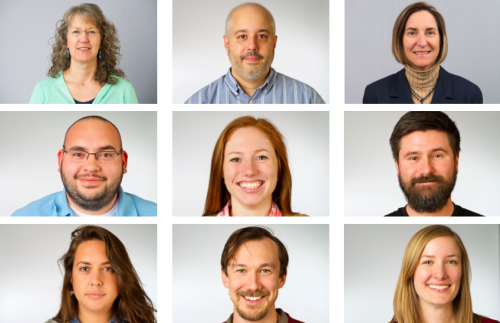
Stephanie Smith provided an analysis of what content was being viewed the most often and for the longest time periods. We learned that visual content and lists were popular, as were stories about restoration, wildlife and bay health. Ongoing challenges include reaching people regarding policy issues and climate change. The Chesapeake Bay Program enewsletters are increasingly popular, including the daily (Bay News), weekly (Bay Brief) and monthly (Chesapeake Currents) enewsletters. Popular Facebook content was wildlife and 'good news' stories, popular Twitter content was breaking news and science, popular Pinterest content was critters, recipes and scenery and popular Instagram content was wildlife and scenery.
In a talk entitled 'Responsible responsive design', Zach Friedman provided an interesting analogy of the paradigm shift that occurred with the growth of automobile travel in U.S. history with the paradigm shift that is occurring with the growth of the Internet. He observed that 141 million Americans own a smart phone, and why it is crucial to provide responsive design websites that can be viewed on smart phones, tablets and computer screens. He pointed out that smart phones are important in Africa as well, and that some places have smart phones even before they have reliable electricity. This growth in smart phones provides an opportunity to reach broader segments of the population, particularly the underserved community.
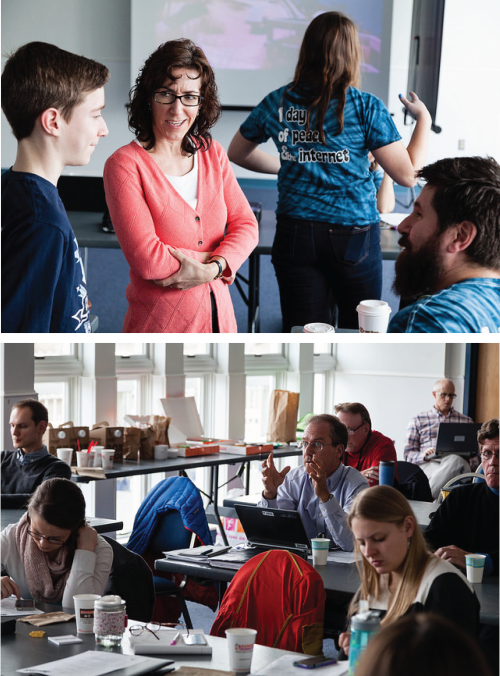
Guy Stephens talked about the importance of 'User testing' in designing, developing and modifying web content. He introduced the concept of UX: user experience which focuses on having a deep understanding of users, what they need, what they value, their abilities and also their limitations. Understanding 'usability' of web content (e.g., user friendly, easy to use, simple, intuitive, fun and satisfying), 'learnability' (how easy is it for users to accomplish basic tasks when they initially encounter the design?), efficiency (how long it takes to perform tasks), memorability (how long to reestablishing proficiency?), error (user error rates, severity and ease of recovery), satisfaction (how pleasant to use the design? User testing can help develop tasks, be used in review evaluations, form recommendations and implement changes. The benefits of user testing include the following: get input from actual users, separate data vs. opinion, distinguish what people do vs. why they say in a survey, inform an iterative enhancement process and ultimately create better products.
Doreen Vetter provided an overview of the revamps underway in the ChesapeakeStat website. She described the three new sections on ChesapeakeStat; 1) Chesapeake Progress, 2) Chesapeake Decisions, and 3) Chesapeake Data. Chesapeake Progress will use accurate, up-to-date and accessible data and information on environmental health, habitat restoration and funding. Chesapeake Decisions will support the adaptive management framework used by the Chesapeake Bay Program and all of its partner organizations. Chesapeake Data will make the extensive data resources more accessible, including novel data sources coming on line (e.g., citizen science).
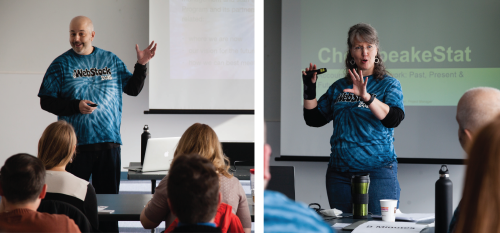
Jenna Valente talked about social media and started off with a great quote "Without promotion, something terrible happens . . . nothing" by P.T. Barnum. Jenna emphasized the importance of maintaining the right tone for all Chesapeake Bay Program communication, which she summarized as 'Authoritative, yet approachable'. She summarized the CBP social media goals as 1) Get found, 2) Strut our stuff, and 3) Interact with people. The team has developed a timing strategy of multiple Twitter posts per day, a daily Facebook, etc. I learned how important it is to use social media as a way to drive people to the ChesapeakeBay.net website.
Will Parson, the multimedia specialist, talked about his goal of helping people fall in love with their piece of the Chesapeake Bay watershed, so that they'll learn to protect it. He showed us some of his arresting photographs and I watched him use his digital SLR camera during Webstock so I can appreciate his talents in taking great photos. Will introduced me to Instagram, something I am not familiar with. Instagram fills a niche for daily, personable content, both photos and short videos, and is used by young people on mobile devices. His list of Instagram best practice was a) post often, b) reciprocate, and c) use analytics. He encouraged everyone to participate and made the point that while you may not be a photographer, you're good enough.

Stephanie Smith talked about branding and identified three aspects: 1) Look (logo, colors, fonts), 2) Voice (tagline, messaging, tone), 3) Heart (mission, beliefs, stories). Branding influences perception, engagement, trust, and loyalty of your organization. In building brand awareness, consistency (letting audience know what to expect), presence (go to where the audience is), integration (relate everything to the brand), content (creating great web products) and frequency (building trust and loyalty) are important. We talked about what the Chesapeake Bay Program brand is and came up with words like knowledgeable, approachable, trustworthy, collaborative, watershed, and expertise.
Bill Whorton talked about the JavaScript revolution. He provided a short history of JavaScript which was invented at Netscape in 1995 as a scripting language for non-professional programmers. He showed some funny examples of websites from circa 1996 to contrast to modern websites that largely use at least some JavaScript. JavaScript is an open source, standardized language that is used widely. It has blurred the lines between 'applications' and websites. One of the things Bill said that I really liked was the following "We're science communicators. Staying apace with technology is key to our credibility." He emphasized that responsive, data-rich, interactive websites pull people in and keep them coming back.

Catherine Krikstan talked about how we are all web team members and how everyone can become involved. She used an example of updating the Bay Field Guide. First, a process of discovery by identifying a) the audience, b) user needs, c) content needs and d) the business case. The discovery phase is followed by brainstorming, using a 'design sprint' technique, in which safe, creative spaces allow for truly collaborative experiences. She also provided examples of user testing feedback to guide the website design and development.
Margaret Enloe emphasized the importance of storytelling in human interactions, which began 40,000 years ago with cave paintings. Margaret played a YouTube clip from a TED-Ed talk by Matthew Winkler called 'What makes a hero?', based on Joseph Campbell's book 'The hero with a thousand faces'. This clip describes the 'Hero's Journey' as a clock face in which the hero progresses twelve o'clock from the status quo to 1) call to adventure, 2) assistance, 3) departure, 4) trials, 5) approach, 6) crisis, 7) treasure, 8) result, 9) return, 10) new life, 11) resolution and back to status quo, but a new status quo. She discussed the importance of distinguishing myth from reality, and providing valuable, original content as what is needed for the Chesapeake Bay Program.
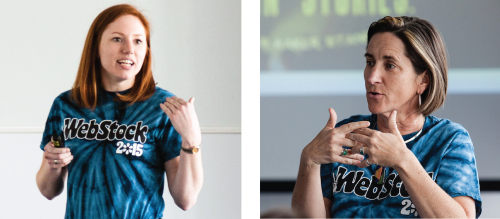
My reflection on this 'One day of Peace and the Internet' was that the Chesapeake Bay Program has assembled a talented, committed web team with knowledge, passion and camaraderie. Someone asked what brand of Kool-aide they were drinking, but I saw this team as a great example of a 'tribe', something I have written about previously. I see a dynamic tension in the creation of synthetic science communication products like our report 'New Insights: Science-based evidence of water quality improvements, challenges, and opportunities in the Chesapeake' vs. the need to generate 4 Twitter posts per day. In addition, the need to tell stories from a people perspective vs. scientific data perspective is something that creates tension, since we generally tell science stories without the human dimension. Resolving these tensions and creating more compelling stories using an authoritative yet approachable voice with a human face is something that will be a goal for the future.
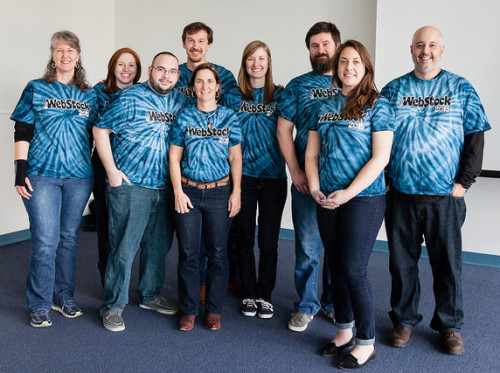
At the end of the day, I provided the lyrics to Webstock, modeled after the musical trio Crosby, Still and Nash song 'Woodstock'. I nominated it as a Chesapeake Bay Program trio (Carin) Bisland, (Rich) Batuik and (Jim) Edward song with the following lyrics:
Webstock 2015
William C. Dennison
19 March 2015
Well I came across a child of Chesapeake, she was walking along the road
And I asked her tell where are you going, this she told me:
Well, I'm going down to Chesapeake Beach, going to join a website jam session.
Got to get back to the Bay, set my soul free.
We are stardust, we are golden, we are billion year old carbon,
And we got to get ourselves back to the Bay.
Well, then can I walk beside you? I have come to lose the smog.
And I feel like I'm a cog in something turning.
And maybe it's the time of year, yes, and maybe it's the time of life.
And I don't know who I am but life is for learning.
We are stardust, we are golden, we are billion year old carbon,
And we got to get ourselves back to the Bay.
By the time we got to Webstock 2015, we were 2.4 million strong,
And everywhere there was song and celebration.
And I dreamed I saw the mobile devices with Bay Program content using social media,
Turning the Bay restoration to best in our nation.
We are stardust, we are golden, we caught in the devil's bargain,
And we got to get ourselves back to the Bay.
About the author
Bill Dennison

Dr. Bill Dennison is a Professor of Marine Science and Interim President at the University of Maryland Center for Environmental Science (UMCES).
Next Post > Brainstorming in the Innovation Room with World Wildlife Fund
Comments
-
Jenna Valente 9 years ago
Wow, thank you for this wonderful overview of the day! We were thrilled to share our experiences and knowledge with you all. I especially appreciated your song at the end. Thanks again and here's to many more Webstocks to come.
-
Atika 5 months ago
Thank you for sharing this great information with us, i really appreciate your post!